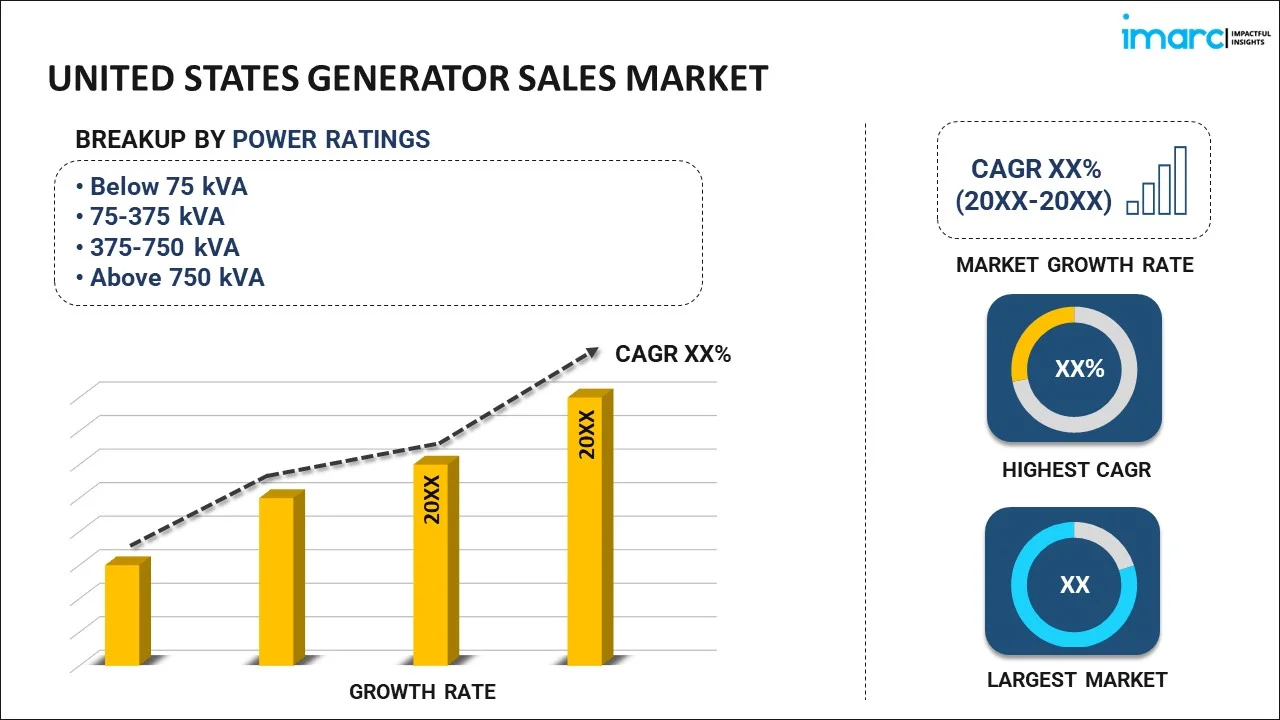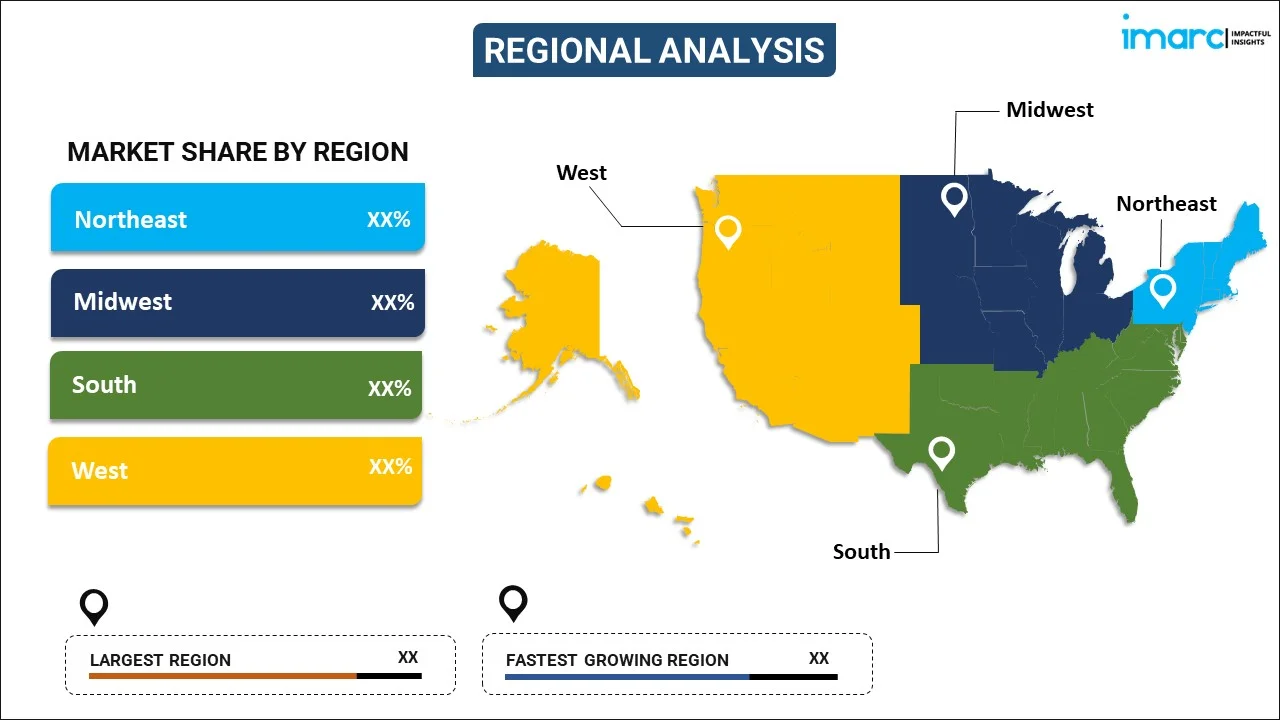
United States Generator Sales Market Report by Power Rating (Below 75 kVA, 75-375 kVA, 375-750 kVA, Above 750 kVA), Fuel Type (Diesel, Gas, and Others), Application (Continuous Load, Peak Load, Standby Load), End Use Industry (Industrial, Commercial, Residential), and Region 2025-2033
Market Overview:
United States generator sales market size reached USD 5.8 Billion in 2024. Looking forward, IMARC Group expects the market to reach USD 8.9 Billion by 2033, exhibiting a growth rate (CAGR) of 4.74% during 2025-2033. The increasing frequency and impact of natural disasters, such as hurricanes, earthquakes, and floods, that can drive the demand for generators as a reliable source of power during emergency situations, is fueling the market.
|
Report Attribute
|
Key Statistics
|
|---|---|
|
Base Year
|
2024
|
|
Forecast Years
|
2025-2033
|
|
Historical Years
|
2019-2024
|
|
Market Size in 2024
|
USD 5.8 Billion |
|
Market Forecast in 2033
|
USD 8.9 Billion |
| Market Growth Rate 2025-2033 | 4.74% |
United States Generator Sales Market Analysis:
- Major Market Drivers: As per the United States generator sales market analysis, increased dependence on uninterrupted power supply for residential, commercial, and industrial applications is driving generator demand faster. Repeated weather-related outages and infrastructure constraints are also encouraging growing investments in backup power systems in both urban and rural regions.
- Key Market Trends: Technological advances in generators, such as intelligent monitoring and remote diagnosis, are revolutionizing operating efficiency. There is also a distinct rise in the use of portable and residential generators due to increased consumer awareness of energy readiness.
- Competitive Landscape: The market offers a broad spectrum of players with specialized solutions in capacity segments. Firms are concentrating on product efficiency, developing distribution channels, and enhancing service capabilities to match changing consumer demands and gain increased market share.
- Challenges and Opportunities: While emissions controls and logistics of supply create operating limitations, new market opportunities are arising with integration into renewable energy systems, increased residential development, and fuel-saving and low-noise innovation for a range of end-user applications.
Generator sales refer to the commercial transactions involving the purchase and distribution of electrical generators. These devices are crucial for providing backup power during outages or serving as the primary power source in off-grid locations. Generator sales encompass a wide range of industries, including construction, healthcare, manufacturing, and residential sectors. Businesses and individuals often invest in generators to ensure uninterrupted operations, safeguard critical equipment, and maintain essential services. The market for generator sales is influenced by factors such as power demand, infrastructure development, and emergency preparedness. As technology advances, the industry sees innovations in fuel efficiency, environmental sustainability, and smart connectivity features. In summary, generator sales play a pivotal role in supporting reliable and resilient power solutions across various sectors, contributing to the overall stability of power infrastructure.
United States Generator Sales Market Trends:
Rising Demand for Backup Power in Commercial and Industrial Sectors
The United States generator sales market is witnessing steady growth, driven by the increasing need for uninterrupted power supply across commercial and industrial sectors. As businesses expand their operations and become more reliant on digitized processes, the risk of operational downtime due to power outages has become a critical concern. This trend is most noticeable in data centers, medical facilities, manufacturing plants, and financial institutions, which demand high availability of power and reliable supply to safeguard vulnerable equipment and ensure business continuity. The increasing susceptibility of the American power grid to extreme weather and peak loads also contributes to the move towards dependable backup power solutions. This trend plays a big role in the growth of the United States generator sales market size, as firms find it more imperative to invest in backup generators to ensure productivity and safeguard infrastructure against unwarranted interruptions.
Use of Smart and Remote Monitoring Technologies
Integration of smart technologies and remote monitoring is the other dominant trend defining the United States generator sales market. Advanced generators are increasingly being loaded with telematics and IoT-based technologies that permit users to monitor performance parameters, fuel economies, and maintenance requirements in real-time. This connectivity provides for real-time proactive management of generator systems, reduces operational downtime, and optimizes efficiency. Remote diagnostics and automated notifications are especially useful in mission-critical applications, such as emergency response systems and utilities, where performance reliability is critical. The use of such intelligent features signifies a significant change in United States generator sales market trends, with customers valuing convenience, predictive maintenance, and economical operations. This transformation underpins the call for more technologically advanced generators, providing long-term growth prospects among residential, commercial, and institutional end users.
Growing Use of Portable and Residential Generators
The increasing occurrence of grid instability, coupled with increased consumer knowledge regarding energy readiness, has spurred an increase in the use of portable and home standby generators in the United States. Domestic consumers are increasingly making use of small and efficient generator sets in order to maintain continuity in the event of weather-related blackouts and other disruptions. The portability and affordability of these models also render them desirable for recreational and off-grid purposes. This increasing residential backup power demand is fueling the consistent United States generator sales market growth, particularly in rural and suburban areas where utility outages are more frequent. Furthermore, growing residential building and heightened energy security concerns have also increased the target consumer base for generator manufacturers. With power reliability as a priority household need, the market will continue to grow on a positive note as sustained demand for residential generator systems drives the growth.
United States Generator Sales Market Segmentation:
IMARC Group provides an analysis of the key trends in each segment of the market, along with forecasts at the country level for 2025-2033. Our report has categorized the market based on power rating, fuel type, application, and end use industry.
Power Rating Insights:

To get more information on this market, Request Sample
- Below 75 kVA
- 75-375 kVA
- 375-750 kVA
- Above 750 kVA
The report has provided a detailed breakup and analysis of the market based on the power rating. This includes Below 75 kVA, 75-375 kVA, and 375-750 kVA, and Above 750 kVA.
Fuel Type Insights:
- Diesel
- Gas
- Others
A detailed breakup and analysis of the market based on fuel type have also been provided in the report. This includes diesel, gas, and others.
Application Insights:
- Continuous Load
- Peak Load
- Standby Load
The report has provided a detailed breakup and analysis of the market based on the application. This includes continuous load, peak load, and standby load.
End Use Industry Insights:
- Industrial
- Utilities/Power Generation
- Oil and Gas
- Chemicals and Petrochemicals
- Mining and Metals
- Manufacturing
- Marine
- Construction
- Others
- Commercial
- IT and Telecom
- Healthcare
- Data Centers
- Others
- Residential
A detailed breakup and analysis of the market based on end use industry have also been provided in the report. This includes industrial (utilities/power generation, oil and gas, chemicals and petrochemicals, mining and metals, manufacturing, marine, construction, and others) commercial (IT and telecom, Healthcare, data centers, and others), and residential.
Regional Insights:

- Northeast
- Midwest
- South
- West
The report has also provided a comprehensive analysis of all the major regional markets, which include the Northeast, Midwest, South, and West.
Competitive Landscape:
The market research report has also provided a comprehensive analysis of the competitive landscape in the market. Competitive analysis such as market structure, key player positioning, top winning strategies, competitive dashboard, and company evaluation quadrant has been covered in the report. Also, detailed profiles of all major companies have been provided.
Latest News and Developments:
- In January 2025, Generac launched a 28kW air-cooled residential standby generator, the highest in its class. With seamless integration with ecobee thermostats and PWRcell systems, the product boasts real-time monitoring, fuel savings, and corrosion-resistant enclosures. U.S. availability is scheduled for the second half of 2025 with growing grid instability.
- In June 2025, Cummins introduced its S17 Centum generator set, a sleek 17-liter platform providing up to 1 MW of power. Designed for urban and critical applications, the twin-turbo engine is HVO fuel-capable and emissions compliant, representing a step forward in power density in the U.S. generator sales market.
United States Generator Sales Market Report Coverage:
| Report Features | Details |
|---|---|
| Base Year of the Analysis | 2024 |
| Historical Period | 2019-2024 |
| Forecast Period | 2025-2033 |
| Units | Billion USD |
| Scope of the Report | Exploration of Historical and Forecast Trends, Industry Catalysts and Challenges, Segment-Wise Historical and Predictive Market Assessment:
|
| Power Ratings Covered | Below 75 kVA, 75-375 kVA, 375-750 kVA, Above 750 kVA |
| Fuel Types Covered | Diesel, Gas, Others |
| Applications Covered | Continuous Load, Peak Load, Standby Load |
| End Use Industries Covered |
|
| Regions Covered | Northeast, Midwest, South, West |
| Customization Scope | 10% Free Customization |
| Post-Sale Analyst Support | 10-12 Weeks |
| Delivery Format | PDF and Excel through Email (We can also provide the editable version of the report in PPT/Word format on special request) |
Key Benefits for Stakeholders:
- IMARC’s industry report offers a comprehensive quantitative analysis of various market segments, historical and current market trends, market forecasts, and dynamics of the United States generator sales market from 2019-2033.
- The research report provides the latest information on the market drivers, challenges, and opportunities in the United States generator sales market.
- Porter's five forces analysis assist stakeholders in assessing the impact of new entrants, competitive rivalry, supplier power, buyer power, and the threat of substitution. It helps stakeholders to analyze the level of competition within the United States generator sales industry and its attractiveness.
- A competitive landscape allows stakeholders to understand their competitive environment and provides an insight into the current positions of key players in the market.
Key Questions Answered in This Report
The generator sales market in the United States was valued at USD 5.8 Billion in 2024.
The United States generator sales market is projected to exhibit a (CAGR) of 4.74% during 2025-2033, reaching a value of USD 8.9 Billion by 2033.
Growing power outages, outdated grid infrastructure, and harsh weather conditions are the primary drivers of the United States generator sales market. Growing demand for dependable backup power in residential, commercial, and industrial applications, combined with increasing use of smart and fuel-efficient generators, is further driving market growth across various applications and geographies.
Need more help?
- Speak to our experienced analysts for insights on the current market scenarios.
- Include additional segments and countries to customize the report as per your requirement.
- Gain an unparalleled competitive advantage in your domain by understanding how to utilize the report and positively impacting your operations and revenue.
- For further assistance, please connect with our analysts.
 Request Customization
Request Customization
 Speak to an Analyst
Speak to an Analyst
 Request Brochure
Request Brochure
 Inquire Before Buying
Inquire Before Buying




.webp)




.webp)












